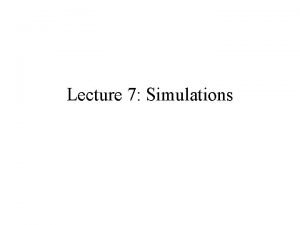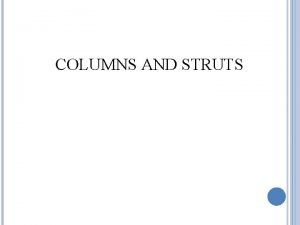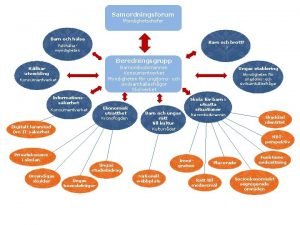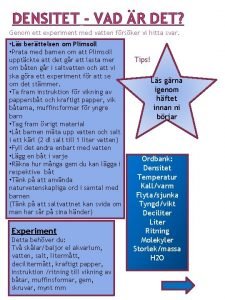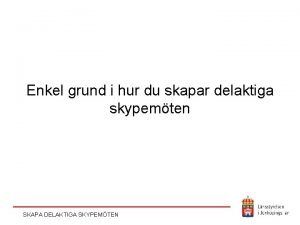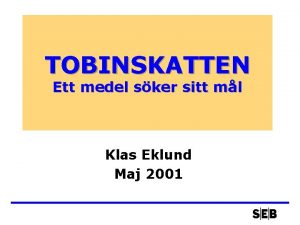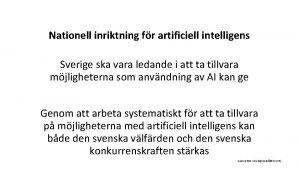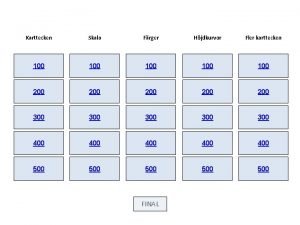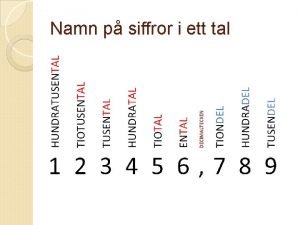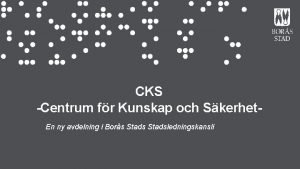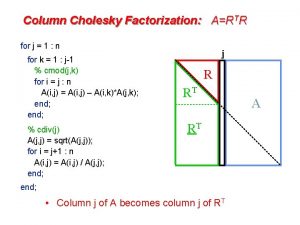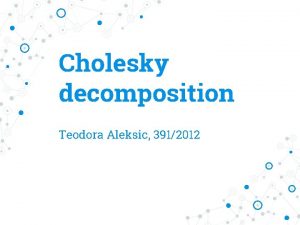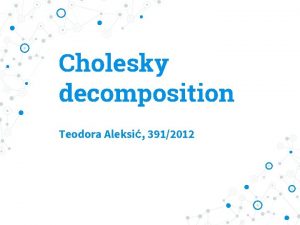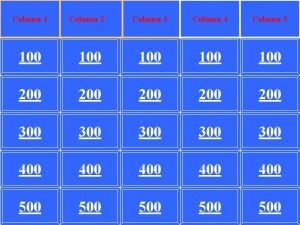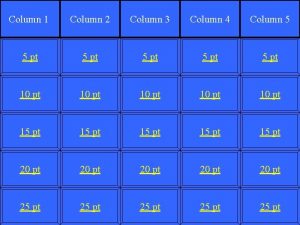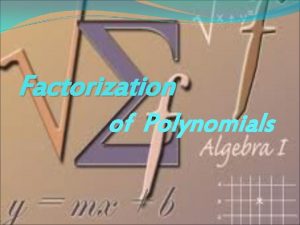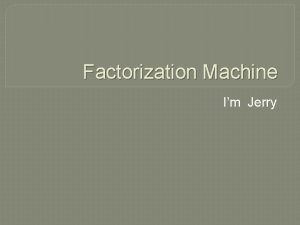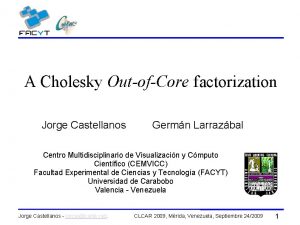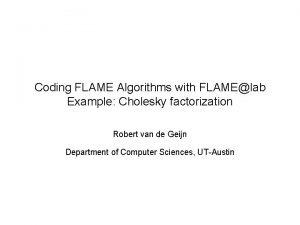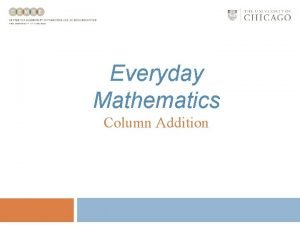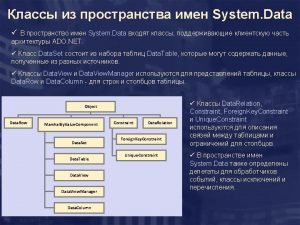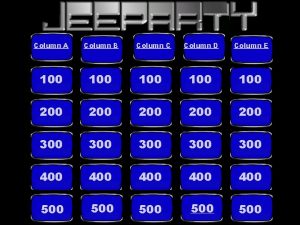Column Cholesky Factorization ARTR for j 1 n
















- Slides: 16

Column Cholesky Factorization: A=RTR for j = 1 : n for k = 1 : j-1 % cmod(j, k) for i = j : n A(i, j) = A(i, j) – A(i, k)*A(j, k); end; % cdiv(j) A(j, j) = sqrt(A(j, j)); for i = j+1 : n A(i, j) = A(i, j) / A(j, j); end; j R RT RT end; • Column j of A becomes column j of RT A

Data structures 31 0 53 0 59 0 41 26 0 • Full: • 2 -dimensional array of real or complex numbers • (nrows*ncols) memory 31 41 59 26 53 1 3 2 3 1 • Sparse: • compressed column storage • about (1. 5*nzs +. 5*ncols) memory D

Sparse Column Cholesky Factorization: A=RTR for j = 1 : n for k < j with A(j, k) nonzero % sparse cmod(j, k) A(j: n, j) = A(j: n, j) – A(j: n, k)*A(j, k); end; % sparse cdiv(j) A(j, j) = sqrt(A(j, j)); A(j+1: n, j) = A(j+1: n, j) / A(j, j); j R RT RT end; • Column j of A becomes column j of RT A

Graphs and Sparse Matrices: Cholesky factorization Fill: new nonzeros in factor 3 1 6 8 4 9 7 G(A) 2 4 9 7 6 8 10 5 3 1 10 5 G+(A) [chordal] 2 Symmetric Gaussian elimination: for j = 1 to n add edges between j’s higher-numbered neighbors

Sparse Cholesky factorization: A=RTR 1. Preorder • Independent of numerics 2. Symbolic Factorization • • Elimination tree Nonzero counts Supernodes Nonzero structure of R 3. Numeric Factorization • • Static data structure Supernodes use BLAS 3 to reduce memory traffic 4. Triangular Solves

Incomplete Cholesky factorization (IC, ILU) x A RT R • Compute factors of A by Gaussian elimination, but ignore fill • Preconditioner B = RTR A, not formed explicitly • Compute B-1 z by triangular solves (in time nnz(A)) • Total storage is O(nnz(A)), static data structure • Either symmetric (IC) or nonsymmetric (ILU)

Incomplete Cholesky and ILU: Variants • Allow one or more “levels of fill” • unpredictable storage requirements 1 4 2 3 • Allow fill whose magnitude exceeds a “drop tolerance” • may get better approximate factors than levels of fill • unpredictable storage requirements • choice of tolerance is ad hoc • Partial pivoting (for nonsymmetric A) • “Modified ILU” (MIC): Add dropped fill to diagonal of U or R • A and RTR have same row sums • good in some PDE contexts

Incomplete Cholesky and ILU: Issues • Choice of parameters • good: smooth transition from iterative to direct methods • bad: very ad hoc, problem-dependent • tradeoff: time per iteration (more fill => more time) vs # of iterations (more fill => fewer iters) • Effectiveness • condition number usually improves (only) by constant factor (except MIC for some problems from PDEs) • still, often good when tuned for a particular class of problems • Parallelism • Triangular solves are not very parallel • Reordering for parallel triangular solve by graph coloring

Matrix permutations: Symmetric direct methods • Goal is to reduce fill, making Cholesky factorization cheaper. • Minimum degree: • Eliminate row/col with fewest nzs, add fill, repeat • Theory: can be suboptimal even on 2 D model problem • Practice: often wins for medium-sized problems • Nested dissection: • Find a separator, number it last, proceed recursively • Theory: approx optimal separators => approx optimal fill and flop count • Practice: often wins for very large problems • Banded orderings (Reverse Cuthill-Mc. Kee, Sloan, . . . ): • Try to keep all nonzeros close to the diagonal • Theory, practice: often wins for “long, thin” problems • Best orderings for direct methods are ND/MD hybrids.

Fill-reducing permutations in Matlab • Nonsymmetric approximate minimum degree: • p = colamd(A); • column permutation: lu(A(: , p)) often sparser than lu(A) • also for QR factorization • Symmetric approximate minimum degree: • p = symamd(A); • symmetric permutation: chol(A(p, p)) often sparser than chol(A) • Reverse Cuthill-Mc. Kee • p = symrcm(A); • A(p, p) often has smaller bandwidth than A • similar to Sparspak RCM D

Matrix permutations for iterative methods • Symmetric matrix permutations don’t change the convergence of unpreconditioned CG • Symmetric matrix permutations affect the quality of an incomplete factorization – poorly understood, controversial • Often banded (RCM) is best for IC(0) / ILU(0) • Often min degree & nested dissection are bad for no-fill incomplete factorization but good if some fill is allowed • Some experiments with orderings that use matrix values • e. g. “minimum discarded fill” order • sometimes effective but expensive to compute

Nonsymmetric matrix permutations for iterative methods • Dynamic permutation: ILU with row or column pivoting • E. g. ILUTP (Saad), Matlab “luinc” • More robust but more expensive than ILUT • Static permutation: Try to increase diagonal dominance • E. g. bipartite weighted matching (Duff & Koster) • Often effective; no theory for quality of preconditioner • Field is not well understood, to say the least

Row permutation for heavy diagonal 1 2 3 4 5 1 1 4 2 2 2 5 3 3 4 4 5 5 3 4 5 A [Duff, Koster] 2 3 4 5 3 1 2 PA • Represent A as a weighted, undirected bipartite graph (one node for each row and one node for each column) • Find matching (set of independent edges) with maximum product of weights • Permute rows to place matching on diagonal • Matching algorithm also gives a row and column scaling to make all diag elts =1 and all off-diag elts <=1

Sparse approximate inverses A B-1 • Compute B-1 A explicitly • Minimize || A B-1 – I ||F (in parallel, by columns) • Variants: factored form of B-1, more fill, . . • Good: very parallel, seldom breaks down • Bad: effectiveness varies widely

Complexity of linear solvers Time to solve model problem (Poisson’s equation) on regular mesh n 1/2 n 1/3 2 D 3 D Sparse Cholesky: O(n 1. 5 ) O(n 2 ) CG, exact arithmetic: O(n 2 ) CG, no precond: O(n 1. 5 ) O(n 1. 33 ) CG, modified IC: O(n 1. 25 ) O(n 1. 17 ) CG, support trees: Multigrid: O(n 1. 20 ) -> O(n 1+ ) O(n 1. 75 ) -> O(n 1. 31 ) O(n)

Complexity of direct methods Time and space to solve any problem on any wellshaped finite element mesh n 1/2 n 1/3 2 D 3 D Space (fill): O(n log n) O(n 4/3 ) Time (flops): O(n 3/2 ) O(n 2 )
 Cholesky decomposition excel
Cholesky decomposition excel Long column and short column
Long column and short column Myndigheten för delaktighet
Myndigheten för delaktighet Rbk-mätning
Rbk-mätning Var 1721 för stormaktssverige
Var 1721 för stormaktssverige Vad är densitet
Vad är densitet Tack för att ni har lyssnat
Tack för att ni har lyssnat Bat mitza
Bat mitza Tobinskatten för och nackdelar
Tobinskatten för och nackdelar Nationell inriktning för artificiell intelligens
Nationell inriktning för artificiell intelligens Vad är referatmarkeringar
Vad är referatmarkeringar Nyckelkompetenser för livslångt lärande
Nyckelkompetenser för livslångt lärande Start för skala
Start för skala Samlade siffror för tryck
Samlade siffror för tryck Cks
Cks Elektronik för barn
Elektronik för barn Underlag för särskild löneskatt på pensionskostnader
Underlag för särskild löneskatt på pensionskostnader
